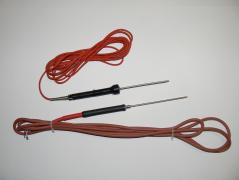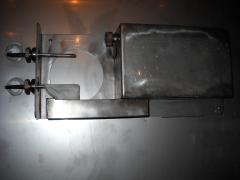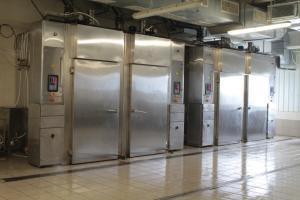Heat treatment of sausage and meat products is one of the important stages in the process of their preparation, since it makes not only the product itself safe, but also provides an attractive appearance and taste characteristics of meat products.
To achieve the set technological goals and obtain the maximum economic result, the meat-processing enterprises are equipped with modern effective thermal equipment that allows to realize all the culinary delights of the technologists. But when operating such equipment, the working thermo separators very often face problems that can not be explained, and which lead to serious losses in the quality of the products during heat treatment: uneven color formation, loss of presentation, excessive loss of moisture in the finished product, appearance of "shriveled" Product, etc.
It turns out that in most cases the problem does not lie in technological mistakes in the preparation of minced meat, not in failures in the operation of thermal chambers, but in the ability of the working thermal department to correctly carry out the process of heat treatment of products, understanding that at what stage should occur both with the product and With technological parameters characterizing the temperature and humidity parameters of the process itself.
In general, the reasons for poor-quality heat treatment can be divided into 3 main groups:
- malfunction or incorrect use of control means (sensors) of process parameters;
- climatic conditions in thermal separation: temperature and humidity in the room;
- technological.
The malfunction of the temperature sensors in the product leads to the most serious violations of the heat treatment process, one of which is the lack of control over the cooking temperature of meat products, which is directly related to the safety of eating such a product.
|
Fig.1 - Designs of needle sensors |
Also distortions of the measured temperature readings in the product can be made by sensors not perfect in design: a very long measuring probe - up to 140 mm and more, and a rather heavy sensor handle (Fig. 1). Also, the sensors, if not completely fall out of the sausage loaves (especially boiled sausages), then shift relative to their axis from the center of the product to the periphery, the temperature of which is much higher. Hence the undercooked product and the disruption of the processes that are performed by the baton sensor. |
Very often, instead of using needle sensors supplied with heat chambers, "smokers" use portable devices to calculate that they are more accurate. This is not a very correct approach, because if the battery level of such a device drops by 15-20%, the measurement readings of such a device will also change.
The simplest way to control the correct operation of the sensors is to measure the temperature of the melt water - 0-1 °C (ice from the ice maker) and measure the temperature of the boiling water - 98-100 °C.
If your sensors show such results, then they are working and you can fully trust their indications.
A very important indicator of the correctness of the heat treatment is the measurement of the relative humidity of the air in the thermal chamber. Although this parameter only indirectly affects the delivery of the product to the culinary readiness of 68-70 °C, with the humidity in the chamber up to 70% and the temperature of 74-75 °C, the product may simply not warm up - it is very informative both in terms of the quality of the process, and diagnostics of the operation of thermal chamber units: shutters, water supply, ventilation, etc.
For example, higher humidity indications on drying may indicate the need to continue the process itself due to incomplete drying of the product shell, or the air intake flap and the exhaust from the heat chambers may not open for some reason (the air compressor is switched off). The increased humidity during smoking, especially the first 5-10 minutes, shows its inefficiency, since the smoke particles settle on the water barrier on the surface of the shell, the reduced moisture in the cooking - the transition to the baking process, which leads to significant losses in the output of the finished product.
|
Fig.2 - Psychrometric Station |
In most cases, one of the reasons for the distortion of the indications of relative humidity is the insufficient care of the wet thermometer bag of the psychrometric stations (Fig. 2), which are used in practically all common smoke-cooking installations. Its absence or strong contamination leads to a distortion of the readings to 95-100% relative humidity. The simplest maintenance is daily washing in a soapy solution, replacing every 2-3 weeks, depending on the intensity of the smoking processes carried out on this thermal chamber. The material of covers is ordinary cotton fabric. |
Another important parameter of conducting heat treatment processes is the measurement of the air temperature inside the thermal chamber. Determination of its actual value and maintenance at each process is due, in the main, to the exclusion of excessive thermal loads at elevated temperatures on the surface of sausage products, which can lead to superficial "quenching" or burst of protein shells during cooking. Indications of the air temperature in the chamber can fluctuate within ± 5 °C depending on the load of the thermal chamber and the time of year, which in no way will affect the quality of the entire process.
The second group of causes of problem heat treatment is directly related to the climatic conditions in the room of the thermal department. Especially it is felt in the premises, not equipped with supply and exhaust ventilation, and in the rooms where the dashing equipment or digesters are directly located. The room that does not have heating will be warmed up to temperatures no higher than 10-12˚C in winter and air with such a temperature will be delivered to the thermo chamber on drying. Naturally, to warm it to the drying temperature of the product (55-65 °C), it will take much longer, which will lead to an increase in the process time and, consequently, an increase in weight loss. The increase in the power of the heating elements of the chambers is not always possible or leads to more severe heat loads of the product at other stages of heat treatment, not to mention the significant consumption of energy carriers.
In summer, the air temperature in the thermal compartment is much higher and can reach 40-50 °C in the suction zones in the heat chamber (under the ceiling), which is comparable or insignificantly lower than the temperatures at which the drying process is carried out in the thermal chamber. As a result, the heating in the thermal chamber is carried out by external air from the room and the frequency of the heating element activation is much lower than usual and evaporation of moisture on the heating element practically does not occur. And if the air in the room has a high humidity (80-90% - the work of the shower or digesters), it is practically impossible to carry out the drying process qualitatively. As a result - incomplete loading of sausage frames, outweighed loaves from the bottom up, an increase in the timing of the process and loss of presentation.
The most effective way to solve this problem is to create normal climatic conditions in a thermal compartment with a constantly maintained temperature in the range of 16-22 °C and a relative air humidity of not more than 80%. In the absence of the possibility of conditioning of such premises, a certain effect is achieved due to the operation of heating in the cold season and the mandatory arrangement of balanced forced supply and exhaust ventilation (Fig. 3).
|
Fig. 3 - Supply and exhaust ventilation |
By "balanced" is meant such ventilation, which creates an air pressure in the room, equal to the atmosphere. Otherwise, if the hood is more powerful, then a vacuum is created and the volume of air sucked into the chamber is reduced, if the ventilation is more powerful, then conditions that are close to street ventilation begin to be created in the room, which is undesirable in the off-season and, especially, in the winter season. This imbalance will unambiguously lead to a deterioration in the performance of drying and ventilation processes. |
Another factor affecting the operation of the chambers in the drying and ventilation mode is the length of the exhaust pipe through which air, smoke or steam exhausted into the atmosphere is emitted. In order to obtain the best effect, the lengths of such pipes should be such that their upper parts are at least 0.5 m above the highest points of buildings in which the thermal separations and adjacent structures are located. In this case, no weather changes in the form of a strong wind or a sudden change in atmospheric pressure will not affect the performance of thermal equipment.
To be continued...



